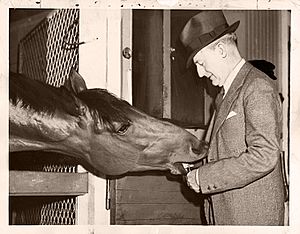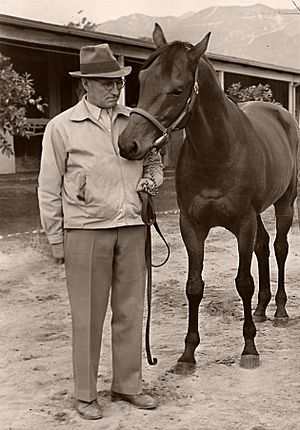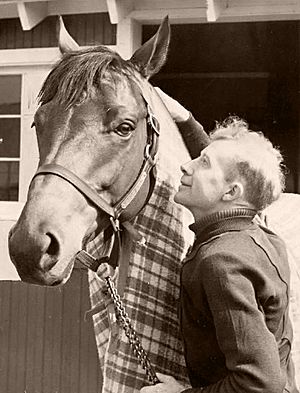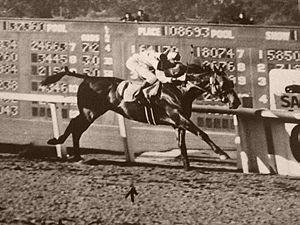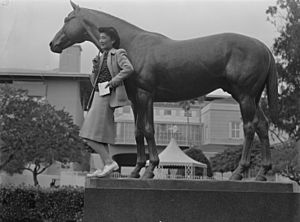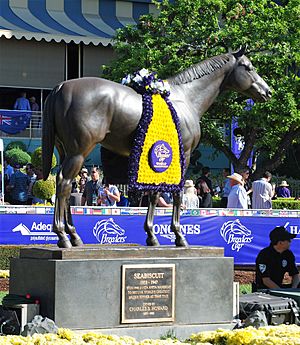Seabiscuit facts for kids
Quick facts for kids Seabiscuit |
|
|---|---|

George Woolf on Seabiscuit
|
|
| Sire | Hard Tack |
| Grandsire | Man o' War |
| Dam | Swing On |
| Damsire | Whisk Broom II |
| Sex | Stallion |
| Foaled | May 23, 1933 |
| Country | United States |
| Colour | Light Bay |
| Breeder | Gladys Mills Phipps |
| Owner | Charles Howard |
| Trainer | 1) "Sunny Jim" Fitzsimmons 2) Tom Smith |
| Record | 89: 33-15-1 |
| Earnings | $437,730 |
| Major wins | |
| Scarsdale Handicap (1936) Massachusetts Handicap (1937) Brooklyn Handicap (1937) Butler Memorial Handicap (1937) Riggs Handicap (1937) San Juan Capistrano Handicap (1937) Bay Meadows Handicap (1937, 1938) Agua Caliente Handicap (1938) Havre de Grace Handicap (1938) Match race vs Ligaroti (1938) Pimlico Special vs War Admiral (1938) Hollywood Gold Cup (1938) San Antonio Handicap (1940) Santa Anita Handicap (1940) |
|
| Awards | |
| U.S. Champion Handicap Male (1937 & 1938) U.S. Horse of the Year (1938) |
|
| Honors | |
| United States Racing Hall of Fame (1958) #25 – Top 100 U.S. Racehorses of the 20th Century Life-size statues at Santa Anita Park and Saratoga Springs |
|
| Last updated on June 19, 2020 | |
Seabiscuit (born May 23, 1933 – died May 17, 1947) was a famous thoroughbred racehorse in the United States. He became the horse who won the most money in races by the 1940s. He famously beat War Admiral, a Triple Crown winner, in a special two-horse race. Seabiscuit was named American Horse of the Year in 1938.
Seabiscuit was a small horse, standing at 15.2 hands tall. His racing career started slowly, as he won only a quarter of his first 40 races. But he became an unexpected champion. He gave many Americans hope during the Great Depression, a time when many people faced hardship.
Seabiscuit's story has been told in many books and films. These include the Shirley Temple movie The Story of Seabiscuit (1949). A popular book, Seabiscuit: An American Legend (1999) by Laura Hillenbrand, was also made into a movie. The film Seabiscuit (2003) was even nominated for an Academy Award for Best Picture.
Contents
Seabiscuit's Early Life
Seabiscuit was born in Lexington, Kentucky, on May 23, 1933. His mother was a mare named Swing On, and his father was Hard Tack. Hard Tack was a son of the legendary racehorse Man o' War. Seabiscuit got his name from his father. "Hardtack" or "sea biscuit" is a type of hard cracker that sailors used to eat.
The bay-colored colt grew up at Claiborne Farm in Paris, Kentucky. He was trained there. Seabiscuit was smaller than other horses. He had knobby knees and loved to sleep and eat for long periods.
At first, Seabiscuit was owned by the powerful Wheatley Stable. His trainer was "Sunny Jim" Fitzsimmons. Fitzsimmons had trained Gallant Fox to win the United States Triple Crown of Thoroughbred Racing. He saw some talent in Seabiscuit but thought the horse was too lazy. Fitzsimmons spent most of his time training Omaha, who won the Triple Crown in 1935.
Seabiscuit was put into many smaller races. He did not win his first 17 races, often finishing far behind. Fitzsimmons didn't spend much time on him, and other stable workers sometimes made jokes about the horse. Seabiscuit started to get attention after winning two races at Narragansett Park. He even set a new track record in the second race. As a two-year-old, Seabiscuit raced 35 times, which is a very busy schedule. He won five times and finished second seven times. He was even in three claiming races, where he could have been bought for $2,500. But no one bought him.
Even though Seabiscuit hadn't reached his full potential, he wasn't as bad as Fitzsimmons thought. His last two wins as a two-year-old were in minor races. The next season started similarly. The colt raced 12 times in less than four months, winning four times. One of these wins was a small race on June 29, 1936, at Suffolk Downs. This is where trainer Tom Smith first saw Seabiscuit. In August, Seabiscuit's owners sold him to car businessman Charles S. Howard for $8,000 at Saratoga.
Becoming a Champion: 1936-1937
Charles Howard gave Seabiscuit to a new trainer, Tom Smith. Smith used unusual training methods. He slowly helped Seabiscuit become more energetic. Smith paired the horse with Canadian jockey Red Pollard (1909–1981). Pollard had experience racing in the West and in Mexico. On August 22, 1936, they raced Seabiscuit for the first time.
Seabiscuit quickly improved. In their next eight races in the East, Seabiscuit and Pollard won several times. These wins included the Detroit Governor's Handicap and the Scarsdale Handicap at Empire City Race Track in Yonkers, New York.
In early November 1936, Howard and Smith sent Seabiscuit to California by train. His last two races of the year were at Bay Meadows in San Mateo, California. In the first race, the Bay Bridge Handicap, Seabiscuit started poorly. He also carried the most weight at 116 pounds. But he still won by five lengths. In the World's Fair Handicap, Seabiscuit led the whole race.
In 1937, the Santa Anita Handicap was California's most important race. It was worth over $125,000 to the winner, which was a huge amount of money. It was called "The Hundred Grander." In his first warm-up race at Santa Anita Park, Seabiscuit won easily. In his second race of 1937, the San Antonio Handicap, he had trouble. He was bumped at the start and pushed wide. Seabiscuit finished fifth, losing to Rosemont.
The two horses raced again in the Santa Anita Handicap a week later. Rosemont won by a nose. This loss was very upsetting for Smith and Howard. Many news reports blamed the jockey. Pollard, who had not seen Rosemont coming until it was too late, was blind in one eye. He had kept this a secret throughout his career. A week after this loss, Seabiscuit won the San Juan Capistrano Handicap by seven lengths. He set a new track record for the distance.
Seabiscuit quickly became a favorite among California racing fans. His fame grew as he won his next three races. Because of his success, Howard decided to send the horse to the East Coast for its more famous racing circuit.
Seabiscuit's winning streak continued. Between June 26 and August 7, he raced five times. Each time was a stakes race, and he won every one. He carried more and more weight in each race, up to 130 pounds. For the third time, Seabiscuit raced against Rosemont. This time, he beat Rosemont by seven lengths. On September 11, Smith agreed to let Seabiscuit carry 132 pounds for the Narragansett Special. On race day, the ground was wet and heavy, which was not good for Seabiscuit. Smith wanted to pull the horse from the race, but Howard said no. Seabiscuit finished third, ending his winning streak. But the season wasn't over. Seabiscuit won his next three races (one was a tie) before finishing the year with a second place at Pimlico.
In 1937, Seabiscuit won 11 of his 15 races. He was the top money winner in the United States that year. War Admiral won the Triple Crown that season. He was voted the most important award, the American Horse of the Year Award.
The Famous Match Race: 1938
In 1938, as a five-year-old, Seabiscuit kept winning. On February 19, his jockey, Pollard, had a terrible fall while racing another horse. Pollard's chest was badly injured. Howard had to find a new jockey. After trying three, he chose George Woolf. Woolf was already a successful rider and an old friend of Pollard's.
Woolf's first race with Seabiscuit was the Santa Anita Handicap. This was the big race the horse had almost won the year before. Seabiscuit started on the outside. Another horse, Count Atlas, moved into his way. They were stuck together for the first part of the race. By the time Woolf got Seabiscuit free, they were six lengths behind. Seabiscuit worked his way to the front but lost by a tiny bit in a photo finish. He lost to Stagehand, who carried 30 pounds less weight than Seabiscuit.
Throughout 1937 and 1938, the news talked a lot about a special race. Everyone wanted to see Seabiscuit race against the amazing War Admiral. War Admiral was sired by Man o' War, Seabiscuit's grandfather. The two horses were supposed to meet in three races, but one or the other was always pulled out. This was usually because Seabiscuit didn't like heavy ground. After many talks, the owners set up a match race for May 1938 at Belmont. But Seabiscuit was pulled from that race too.
By June, Pollard had recovered. On June 23, he agreed to ride a young colt named Modern Youth. Something on the track scared the horse. It ran quickly through the stables and threw Pollard off. Pollard's leg was shattered, and it seemed his career was over.
Howard then set up a match race for Seabiscuit against Ligaroti. Ligaroti was a highly rated horse owned by Hollywood entertainer Bing Crosby. This race was organized to promote Crosby's resort and Del Mar Racetrack in Del Mar, California. With Woolf riding, Seabiscuit won that race. This was despite Ligaroti's jockey trying to interfere. After three more races with only one win, Seabiscuit was set to race War Admiral in the Pimlico Special in November. This race would be in Baltimore, Maryland.
Before the big race, on October 16, 1938, Seabiscuit ran second in the Laurel Stakes. He lost by two lengths to the filly Jacola. Jacola set a new record at Laurel Park Racecourse for one mile.
"George Woolf always said he never had more fun on a racehorse than he did that day in 1938 at Pimlico, when Tom Smith, the horse's trainer, lifted Woolf aboard Seabiscuit for the big match race against War Admiral."
On November 1, 1938, Seabiscuit met War Admiral and jockey Charles Kurtsinger. This race was called the "Match of the Century." It was run over 1 and 3/16 miles at Pimlico Race Course. The track was packed with fans, from the grandstands to the middle of the track. Trains brought fans from all over the country. About 40,000 people were at the track, and 40 million listened on the radio. War Admiral was the favorite to win. Most writers and experts picked him, except for those from California.
Head-to-head races are good for horses that start fast. War Admiral was known for his speed from the gate. Seabiscuit, on the other hand, usually started slower and then sped up later in the race. Few people thought Seabiscuit could lead War Admiral into the first turn. But Smith knew this. He trained Seabiscuit to start very fast. He used a starting bell and a whip to make the horse burst forward at the start.
When the bell rang, Seabiscuit broke in front. He was more than a length ahead after 20 seconds. He quickly moved to the rail position. Halfway down the backstretch, War Admiral started to catch up. He pulled even with Seabiscuit, then slightly ahead. Woolf remembered advice from Pollard. He eased up on Seabiscuit, letting his horse see War Admiral. Then he asked Seabiscuit for more effort. Two hundred yards from the finish line, Seabiscuit pulled ahead again. He kept extending his lead and won by four lengths. War Admiral even ran his best time for that distance.
Because of his races that year, Seabiscuit was named American Horse of the Year for 1938. He beat War Admiral by a lot of points in a poll. Seabiscuit was the most talked-about newsmaker of 1938. The only big prize he hadn't won was the Santa Anita Handicap.
Injury and Comeback
Seabiscuit got injured during a race. Woolf, who was riding him, said he felt the horse stumble. The injury was not life-threatening. But many people thought Seabiscuit would never race again. The doctors said he had a ruptured suspensory ligament in his front left leg. With Seabiscuit out of action, Smith and Howard focused on their other horse, Kayak II. Kayak II was a stallion from Argentina. In the spring of 1939, Seabiscuit bred with seven of Howard's mares. All of them had healthy foals in the spring of 1940.
Seabiscuit and Pollard, who was still recovering, got better together at Howard's ranch. Pollard's new wife, Agnes, helped him recover. Slowly, both the horse and the rider learned to walk again. Pollard joked that they "had four good legs between" them. A local doctor broke and reset Pollard's leg to help it heal. Slowly, Pollard felt confident enough to sit on a horse again. He wore a brace to support his weak leg. He started riding Seabiscuit again, first walking, then trotting, and then cantering. Howard was very happy to see them improve. He really wanted Seabiscuit to race again. But he was also very worried about Pollard, whose leg was still fragile.
In the fall and winter of 1939, Seabiscuit seemed to get fitter every day. By the end of the year, Smith was ready to train the horse for races again. Different stable jockeys rode him during training. By the time of his comeback race, Pollard had convinced Howard to let him ride. The horse was pulled from one race because the ground was too soft. But then, the pair finally lined up for the La Jolla Handicap at Santa Anita on February 9, 1940. Seabiscuit finished third, beaten by two lengths. By their third comeback race, Seabiscuit was winning again. He easily won the San Antonio Handicap. He beat his training partner, Kayak II, by two and a half lengths. Seabiscuit carried 124 pounds and tied the track record for a mile and 1/16.
One race was left in the season. A week after the San Antonio, Seabiscuit and Kayak II both entered the Santa Anita Handicap. The prize was $121,000. 78,000 paying fans packed the racetrack. Most of them were cheering for Seabiscuit. Pollard found his horse blocked almost from the start. Seabiscuit worked his way through the other horses and briefly took the lead. As they raced down the back straight, Seabiscuit got stuck in third place. He was behind the leader, Whichcee, and Wedding Call on the outside.
Pollard trusted his horse's speed. He steered Seabiscuit between the leaders. Seabiscuit burst into the lead, moving to the firm ground just off the rail. As Seabiscuit showed his old burst of speed, Wedding Call and Whichcee slowed down. Pollard pushed his horse on. Seabiscuit won "The Hundred Grander" by a length and a half, with Kayak II closing fast behind him. The crowd went wild. Neither the horse and rider, nor the trainer and owner, could get through the crowd to the winner's area for some time.
Retirement and Later Life
On April 10, 1940, Seabiscuit's retirement from racing was officially announced. When he retired to the Ridgewood Ranch near Willits, California, he was the horse who had won the most money in racing history. As a breeding horse, Seabiscuit had 108 foals. Two of them, Sea Sovereign and Sea Swallow, became somewhat successful racehorses. Over 50,000 visitors came to Ridgewood Ranch to see Seabiscuit in the seven years before he died.
Death and Burial
Seabiscuit died on May 17, 1947, in Willits, California. He was almost 14 years old. Doctors believed he died of a heart attack. He is buried at Ridgewood Ranch in Mendocino County, California.
Legacy and Honors
Awards and Special Recognitions
- In 1958, Seabiscuit was voted into the National Museum of Racing and Hall of Fame.
- In the Blood-Horse magazine's List of the Top 100 U.S. Racehorses of the 20th Century (1999), Seabiscuit was ranked 25th. War Admiral was 13th, and Seabiscuit's grandfather, Man o' War, was ranked 1st.
Seabiscuit in Movies and TV
Documentaries
- American Experience: "Seabiscuit" (April 21, 2003) was a documentary episode. It aired as part of the PBS American Experience series.
- ESPN SportsCentury: "Seabiscuit" (November 17, 2003) featured Seabiscuit in ESPN's Greatest Athletes series.
- The True Story of Seabiscuit (July 27, 2003) was a 45-minute TV documentary. It included interviews and footage with William H. Macy, Seabiscuit, and Tobey Maguire. It aired on the USA Network.
- Seabiscuit: the Lost Documentary (1939) was made by Seabiscuit's owner, Charles Howard. It was later colorized and released in 2003.
- Seabiscuit: America's Legendary Racehorse (2003) was directed and produced by Nick Krantz.
Fiction Films
- Stablemates (1938) used actual footage of Seabiscuit running in the Hollywood Gold Cup race.
- Porky and Teabiscuit (1939) is a Warner Bros. Porky Pig cartoon. It's a funny take on Seabiscuit's underdog story.
- The Story of Seabiscuit (1949), starring Shirley Temple, was a made-up story. But it did include real footage of the 1938 match race against War Admiral and the 1940 Santa Anita Handicap.
- Seabiscuit (2003) was a movie based on Laura Hillenbrand's popular book. It was nominated for seven Academy Awards, including Best Picture.
- The Making of Seabiscuit (December 16, 2003) was a short documentary. It showed how the 2003 movie was made.
Books About Seabiscuit
- Track writer B.K. Beckwith wrote Seabiscuit: The Saga of a Great Champion (1940). This book came out right after Seabiscuit's Santa Anita win and his retirement.
- Ralph Moody wrote Come On, Seabiscuit! (1963).
- Laura Hillenbrand's book Seabiscuit: An American Legend (2001) became a bestseller. It was later made into the 2003 film.
Postage Stamp
In 2009, Seabiscuit was honored by the United States Postal Service with a stamp. This happened after an 8-year effort by Maggie Van Ostrand and Chuck Lustick. Thousands of people signed petitions to make this happen.
Statues Honoring Seabiscuit
- A statue of Seabiscuit sits outside The Shops at Tanforan. This shopping mall is built where the Tanforan Racetrack used to be. Seabiscuit stayed there briefly in 1939.
- In the 1940s, businessman W. Arnold Hanger gave a small statue of Seabiscuit to the Keeneland library.
- In 1941, a life-sized bronze statue of Seabiscuit was put up at Santa Anita Park. It is now in the "Seabiscuit Court" at the track.
- On June 23, 2007, another statue of Seabiscuit was shown at Ridgewood Ranch.
- In 1941, sculptor Hughlette "Tex" Wheeler made two bronze statues of Seabiscuit. One is at Santa Anita racetrack. The other is in Saratoga Springs, outside the National Museum of Racing.
- On July 17, 2010, a life-size statue of George Woolf and Seabiscuit was shown. It is at the Remington Carriage Museum in Woolf's hometown of Cardston, Alberta. This happened near the 100th anniversary of Woolf's birth.
Notable Race Wins
Seabiscuit raced 89 times at 16 different distances during his career.
- Brooklyn Handicap (1937)
- San Antonio Handicap (1940)
- Santa Anita Handicap (1940)
^ a: The Saturday Evening Post, dated April 27, 1940, reported: "By the following March the horse failed only by inches—because his jockey erred in looking back—to win in his first try at the Santa Anita Handicap, richest of all races."
- Beckwith, B.K. (1940), Seabiscuit: The Saga of a Great Champion, with drawings by Howard Brodie, Wilfred Crowell, Inc., San Francisco.
- Hillenbrand, Laura (2001), Seabiscuit: An American Legend.
- Rasmussen, Zach (2013), Seabiscuit: An Unlikely Champion.
See also
 In Spanish: Seabiscuit (caballo) para niños
In Spanish: Seabiscuit (caballo) para niños


